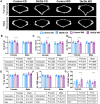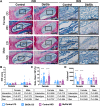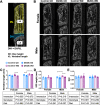Leptin signaling and the intervertebral disc: Sex dependent effects of leptin receptor deficiency and Western diet on the spine in a type 2 diabetes mouse model
- PMID: 32374776
- PMCID: PMC7202633
- DOI: 10.1371/journal.pone.0227527
Leptin signaling and the intervertebral disc: Sex dependent effects of leptin receptor deficiency and Western diet on the spine in a type 2 diabetes mouse model
Abstract
Type 2 diabetes and obesity are associated with back pain in juveniles and adults and are implicated in intervertebral disc (IVD) degeneration. Hypercaloric Western diets are associated with both obesity and type 2 diabetes. The objective of this study was to determine if obesity and type 2 diabetes result in spinal pathology in a sex-specific manner using in vivo diabetic and dietary mouse models. Leptin is an appetite-regulating hormone, and its deficiency leads to polyphagia, resulting in obesity and diabetes. Leptin is also associated with IVD degeneration, and increased expression of its receptor was identified in degenerated IVDs. We used young, leptin receptor deficient (Db/Db) mice to mimic the effect of diet and diabetes on adolescents. Db/Db and Control mice were fed either Western or Control diets, and were sacrificed at 3 months of age. Db/Db mice were obese, while only female mice developed diabetes. Female Db/Db mice displayed altered IVD morphology, with increased intradiscal notochordal band area, suggesting delayed IVD cell proliferation and differentiation, rather than IVD degeneration. Motion segments from Db/Db mice exhibited increased failure risk with decreased torsional failure strength. Db/Db mice also had inferior bone quality, which was most prominent in females. We conclude that obesity and diabetes due to impaired leptin signaling contribute to pathological changes in vertebrae, as well as an immature IVD phenotype, particularly of females, suggesting a sex-dependent role of leptin in the spine.
Conflict of interest statement
The authors have declared that no competing interests exist.
Figures








Similar articles
-
Intervertebral disc degeneration in mice with type II diabetes induced by leptin receptor deficiency.BMC Musculoskelet Disord. 2020 Feb 5;21(1):77. doi: 10.1186/s12891-020-3091-1. BMC Musculoskelet Disord. 2020. PMID: 32024487 Free PMC article.
-
Leptin and the intervertebral disc: a biochemical link exists between obesity, intervertebral disc degeneration and low back pain-an in vitro study in a bovine model.Eur Spine J. 2019 Feb;28(2):214-223. doi: 10.1007/s00586-018-5778-7. Epub 2018 Oct 15. Eur Spine J. 2019. PMID: 30324498
-
Exploring the endocannabinoidome in genetically obese (ob/ob) and diabetic (db/db) mice: Links with inflammation and gut microbiota.Biochim Biophys Acta Mol Cell Biol Lipids. 2022 Jan;1867(1):159056. doi: 10.1016/j.bbalip.2021.159056. Epub 2021 Oct 1. Biochim Biophys Acta Mol Cell Biol Lipids. 2022. PMID: 34606993
-
Intervertebral Disc and Adipokine Leptin-Loves Me, Loves Me Not.Int J Mol Sci. 2020 Dec 31;22(1):375. doi: 10.3390/ijms22010375. Int J Mol Sci. 2020. PMID: 33396484 Free PMC article. Review.
-
The Relationship between Diabetes Mellitus Type II and Intervertebral Disc Degeneration in Diabetic Rodent Models: A Systematic and Comprehensive Review.Cells. 2020 Sep 29;9(10):2208. doi: 10.3390/cells9102208. Cells. 2020. PMID: 33003542 Free PMC article.
Cited by
-
Complications in the spine associated with type 2 diabetes: The role of advanced glycation end-products.Med Nov Technol Devices. 2021 Sep;11:100065. doi: 10.1016/j.medntd.2021.100065. Epub 2021 Mar 2. Med Nov Technol Devices. 2021. PMID: 35992525 Free PMC article.
-
Controversies in spine research: Organ culture versus in vivo models for studies of the intervertebral disc.JOR Spine. 2022 Nov 28;5(4):e1235. doi: 10.1002/jsp2.1235. eCollection 2022 Dec. JOR Spine. 2022. PMID: 36601369 Free PMC article. Review.
-
High fat diet causes inferior vertebral structure and function without disc degeneration in RAGE-KO mice.J Orthop Res. 2022 Jul;40(7):1672-1686. doi: 10.1002/jor.25191. Epub 2021 Oct 21. J Orthop Res. 2022. PMID: 34676612 Free PMC article.
-
Secreted chemokines and transcriptomic analyses reveal diverse inflammatory and degenerative processes in the intervertebral disc of the STZ-HFD mouse model of Type 2 diabetes.bioRxiv [Preprint]. 2025 Mar 25:2024.07.31.605332. doi: 10.1101/2024.07.31.605332. bioRxiv. 2025. PMID: 39131361 Free PMC article. Preprint.
-
Effects of Sex and Obesity on LEP Variant and Leptin Level Associations in Intervertebral Disc Degeneration.Int J Mol Sci. 2022 Oct 14;23(20):12275. doi: 10.3390/ijms232012275. Int J Mol Sci. 2022. PMID: 36293132 Free PMC article.
References
-
- Vos T, Allen C, Arora M (2016) Global, regional, and national incidence, prevalence, and years lived with disability for 310 diseases and injuries, 1990–2015: a systematic analysis for the Global Burden of Disease Study 2015. The Lancet 388: 1545–1602. 10.1016/S0140-6736(16)31678-6 - DOI - PMC - PubMed
-
- Hales CM, Carroll MD, Fryar CD, Ogden CL (2017) Prevalence of Obesity Among Adults and Youth: United States, 2015–2016. NCHS Data Brief: 1–8. - PubMed
Publication types
MeSH terms
Substances
Grants and funding
LinkOut - more resources
Full Text Sources
Medical
Miscellaneous

